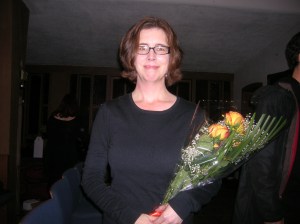 The Dec. 18 concert of Polly Moller‘s works was terrific fun. Most of the pieces were based on instructions and improvisation, and many took their concepts from nature, pagan mythos, and… for lack of a better word, I’ll say “magic.”
The Dec. 18 concert of Polly Moller‘s works was terrific fun. Most of the pieces were based on instructions and improvisation, and many took their concepts from nature, pagan mythos, and… for lack of a better word, I’ll say “magic.”
Pictures taken during the show came out rather fuzzy, since I was sitting in the back. Amar, over at the Catsynth blog, has a better camera and knows how to use it; he might eventually post some pics beyond what I could do.
I’d previously mentioned the show here. And here, now, is a rundown of the program:
The Flip Quartet (2006). The first piece happens to be the hardest to describe. Four improvisers stand at four tables, each representing a compass direction (N,E,S,W) and an element (earth, fire, air, water, not necessarily in that order). Each table is ornamented with various objects for soundmaking — among them: glass, whistles, metal, books to read from, and even a guitar. All four players perform for a set amount of time, then they pause and rotate. (Photo below by Michael Zelner, michaelz1 on Flickr, taken from a 2009 “Flip Quartet” performance.)
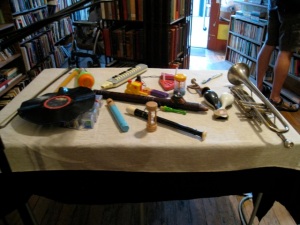 I wish I’d taken notes on how the five movements differed (they played a second time at their original positions, making for five movements). The first seemed quietest and more tentative — in fact, the piece is supposed to be amplified so that the performers can focus on quiet sounds. Some of that did come into effect — the fire table had a book of matches, and the act of striking a match and shaking out the flame sounded interesting over the amplifier. In the third movement, the guy at table 3 tried snapping matches in half. He stopped after only two, probably thinking he wasn’t being heard — but the second match’s snap came through clearly. Nice idea.
I wish I’d taken notes on how the five movements differed (they played a second time at their original positions, making for five movements). The first seemed quietest and more tentative — in fact, the piece is supposed to be amplified so that the performers can focus on quiet sounds. Some of that did come into effect — the fire table had a book of matches, and the act of striking a match and shaking out the flame sounded interesting over the amplifier. In the third movement, the guy at table 3 tried snapping matches in half. He stopped after only two, probably thinking he wasn’t being heard — but the second match’s snap came through clearly. Nice idea.
Part of the exercise, I think, is to see how different improvisers react to the same sets of materials. It’s almost like the piece is challenging them to produce their own sounds out of, say, metal chains and bowls, or innocuous pitchers of water.
Duo No. 1 (2008, premiere). Written for Gino Robair, who played all manner of objects, this duo traces the life cycle of a moth, and the score consists of a diagram of that life cycle, with some dynamic markings (basically showing that the piece is meant to be very, very quiet in the middle). Robair was accompanied by Krystyna Bobrowski on sliding speaker instrument: a tube, the length of which she varied for different sound timbres, altering and accentuating the sounds Robair was feeding into the mic. The piece was quiet but propulsive, and you really could trace events from the breaking of the chrysalis to the final flight into a flame.
Penelope (2010, premiere). Solo piccolo piece for Amy Likar, and possibly the program’s only through-composed piece. It combines sparse piccolo flurries, timed foot stomps, and a breathy “yes” frequently blown into the mouthpiece, all representing Penelope’s monologue that ends Ulysses. There was no set meter, so the piece was unpredictable and the foot stomps irregular: just one continuing flow, much like stream-of-consciousness writing. Very nice.
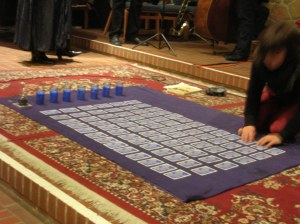 Three of Swords (2009). The most difficult of the pieces, for both performer and audience. It’s solo performance art, with the performer (Sarah Elena Palmer) alternately emitting improvised vocal sounds, conducting a tarot reading, and tuning up what sounded like a shortwave radio. Long pauses, particularly for the tarot-card turning, made this one hard to pull off, but the audience stayed reverently quiet. I liked the effect but came away feeling like I didn’t “get” this one.
Three of Swords (2009). The most difficult of the pieces, for both performer and audience. It’s solo performance art, with the performer (Sarah Elena Palmer) alternately emitting improvised vocal sounds, conducting a tarot reading, and tuning up what sounded like a shortwave radio. Long pauses, particularly for the tarot-card turning, made this one hard to pull off, but the audience stayed reverently quiet. I liked the effect but came away feeling like I didn’t “get” this one.
Alcyone (2010, premiere). By contrast, this piece told a straightforward story: the Greek legend of Alcyone, who calms the winter seas for seven days while incubating her eggs on the waves. A quartet (two saxes, bass, percussion) played tumultuously as Alcyone (mezzo-soprano Laura Malouf-Renning, darkly costumed 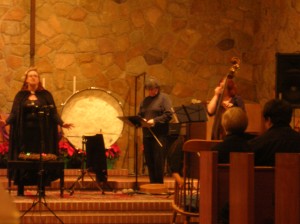 and carrying a nest of Xmas ornaments) arrived and, with a touch, quieted each player in succession, the overall sound slowly receding. Alcyone then got a long monologue/aria, stern and dramatic — I’d be curious if it was actually in Greek, or some language, or whether the syntax was improvised. She ended the piece by cueing each player to return to noisy tossing and turning. A nicely theatrical piece, and the liner notes say Moller is planning seven more, based on Neo-Pagan holidays.
and carrying a nest of Xmas ornaments) arrived and, with a touch, quieted each player in succession, the overall sound slowly receding. Alcyone then got a long monologue/aria, stern and dramatic — I’d be curious if it was actually in Greek, or some language, or whether the syntax was improvised. She ended the piece by cueing each player to return to noisy tossing and turning. A nicely theatrical piece, and the liner notes say Moller is planning seven more, based on Neo-Pagan holidays.
Genesis (2006-2010). A piece for 12 improvisers (with Moller, as conductor, included in that count) and a 13th player: Matt Davignon on electronics, representing the new universe. The concept is clever: the 12 players were arranged in a spiral, with Davignon at the center. Moller walked the spiral, cueing each instrument to play, dronelike, according to scored parts that suggested patterns but didn’t give specifics. Davignon eventually joined in and took over. The sum was a powerful and almost calm sound, surging and receding. (UPDATE: Polly notifies me I’m off by a number: It really is a piece for 12 improvisers, including the conductor and the New Universe person. And, in fact, they were missing a person for this performance — I hadn’t bothered to count them all, I’ll admit.)
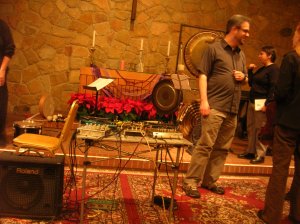 What’s it mean? The latest models in string theory and M theory, at least according to the PBS shows I’ve seen, say the universe is 11-dimensional and occupies a cosmic membrane, called “brane” for short. A further-out postulate is that multiple branes might exist, with their collisions causing the Big Bangs that create universes like ours. Cool, huh? So, Davignon represented the new universe birthed by the actions of these 11 other dimensions
What’s it mean? The latest models in string theory and M theory, at least according to the PBS shows I’ve seen, say the universe is 11-dimensional and occupies a cosmic membrane, called “brane” for short. A further-out postulate is that multiple branes might exist, with their collisions causing the Big Bangs that create universes like ours. Cool, huh? So, Davignon represented the new universe birthed by the actions of these 11 other dimensions (and the role of the conductor is, I presume, an exercise left to the listener).
Again, it was a visual piece, theatrical. Unlike “Alcyone,” the music here tells only a fraction of the story; you have to experience this one live. Davignon’s new universe wasn’t the obvious, ferocious outpouring of a big bang, but more of an audio primoridal ooze, feeling its way outwards into newfound, unfilled dimensions. That was an interesting choice, one that wouldn’t have occurred to me but set the perfect mood.
All told, a wonderful evening of thought-provoking music. Great to see all these musicians in action together, too.
The scores were available for sale, and quite nicely packaged and presented. “Alcyone” comes in black binding; “Duo” is an elegantly rolled-up scroll. The picture below doesn’t do them as much justice as I’d hoped.
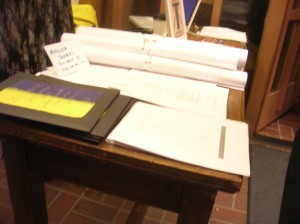
Thanks for the shout-out! I finally got around to posting my review and a few of my photos from the concert on CatSynth.